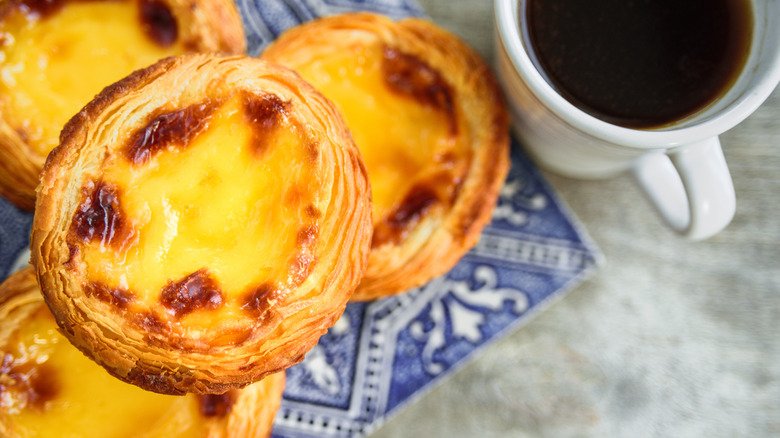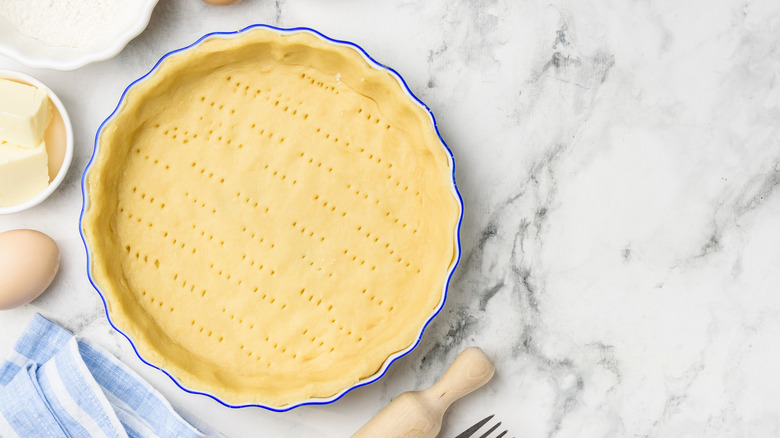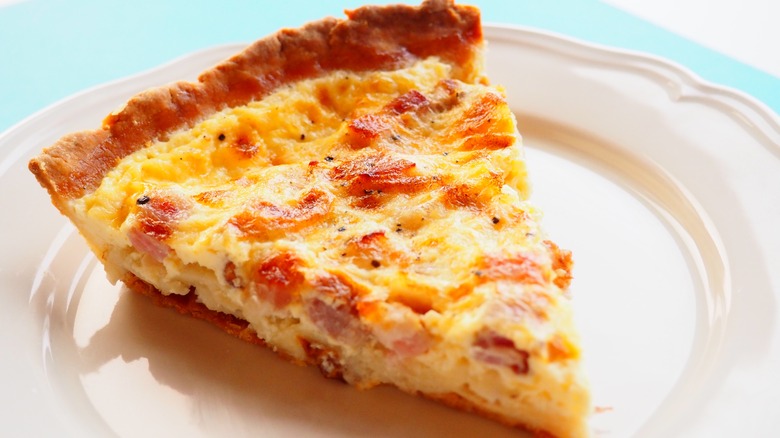What Makes Portuguese Egg Tarts Different From A Quiche?
While both Portuguese egg tarts and quiche include an egg-based custard filling and buttery crust, the similarities mostly stop there. They have big differences in their fillings, types of dough, baking temperatures, and flavor profiles. Portuguese egg tarts, known as pastel (singular) or pastéis (plural) de nata, are sweet and creamy with a deeply caramelized top. These pastries are served as a dessert or sweet treat and are typically small enough to fit comfortably in the palm of your hand.
Quiche is always a savory dish and is usually baked in a larger pie or tart pan. A slice is often served with a simple green salad to make a complete meal. Modern quiche is owed to France but is actually descended from a humble German dish called Kische, a savory egg custard baked in a bread crust. When the French took control of the German territory of Lothringen in the 1500s, they called the area Lorraine, and Kische was adapted into "quiche Lorraine." Today, quiche Lorraine usually refers to a version with bacon and cheese, and other versions are just "quiche."
Meanwhile, the history of pastéis de nata goes back several hundred years to either a convent or a monastery, depending on who you ask. Either way, sometime around the 16th century, egg whites were commonly being used to starch laundry in these establishments, and the tarts were born from the necessity to put all those leftover egg yolks to good use.
Quiche vs egg tarts: The crust
The crust for a Portuguese egg tart uses a puff pastry dough called massa folhada, which is made differently than French puff pastry. The French method requires folding a butter-rich dough around cold butter, rolling it out, and then refolding to create many layers of fat and dough. The dough in a Portuguese egg tart recipe still uses multiple passes of folding and rolling, but instead uses butter that is soft and smooth. The dough is also rolled into a log and then sliced to make pinwheels, which are then pressed into molds specifically made for making pastéis de nata. A muffin tin can also be used as a stand-in.
On the other hand, quiche is made from a pastry called pâte brisée. This is essentially an all-butter pie dough, also known as a shortcrust pastry. The butter is fully incorporated, resulting in a crust that is tender, crumbly, and firm, rather than crisp and flaky. It is also thicker and sturdier than the crust of a Portuguese egg tart.
Many quiche recipes call for blind-baking the crust on its own before adding the custard filling, which is then followed by a longer bake at a moderate temperature. Pastéis de nata don't use a pre-baked crust, simply baking both the crust and filling briefly in a very hot oven. The butter in the thinly-rolled dough quickly melts, which then sizzles the pastry to an ultra-crisp finish.
The filling differs a lot, too
Egg tarts are filled with — you guessed it — eggs, combined with flour and a sugary simple syrup, which helps keep it stable during high-heat cooking and also encourages browning. Other common additions include flavoring like cinnamon, lemon, and vanilla, though a rich egginess is supposed to come through as the dominant flavor.
The eggs in a quiche filling are combined with a significant amount of dairy. Though there are variations, a recipe that calls for four eggs may be mixed with as much as two cups of cream or half-and-half. This egg-to-dairy ratio makes for silkier quiches, and the result is less firm than an egg tart filling. A quiche can have any number of vegetable, cheese, and meat fillings, but the aforementioned quiche Lorraine is a classic. Most traditionally, it simply includes the addition of bacon to the creamy egg mixture, though onions and Gruyère or Emmental cheese are also common flavorings.
At the end of the day, these two egg-filled baked goods are quite different, but you really can't go wrong with a flaky, buttery bite of either one. Why not have a slice of quiche for your main and a pastel de nata for dessert? You'll certainly get your daily fill of eggs.
Static Media owns and operates Tasting Table and Food Republic.



